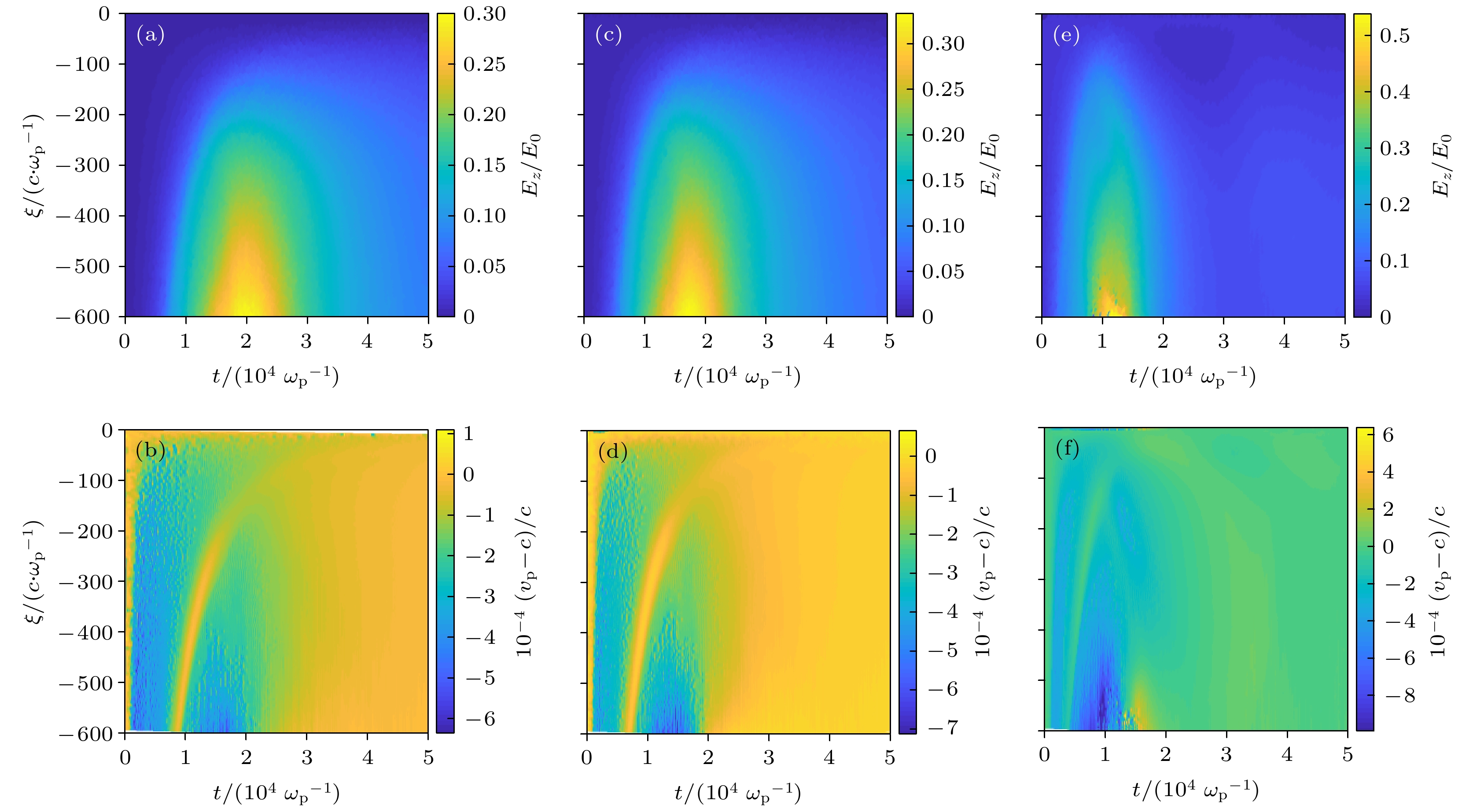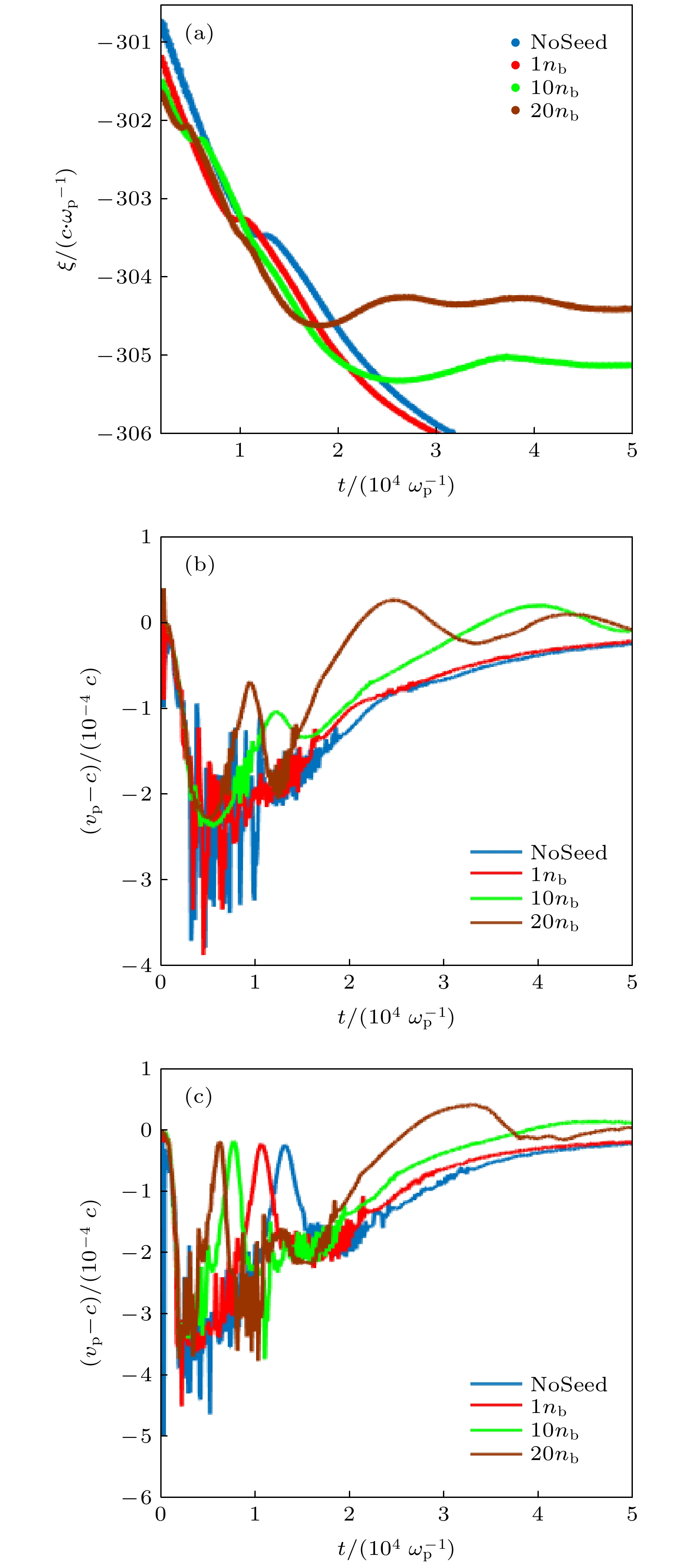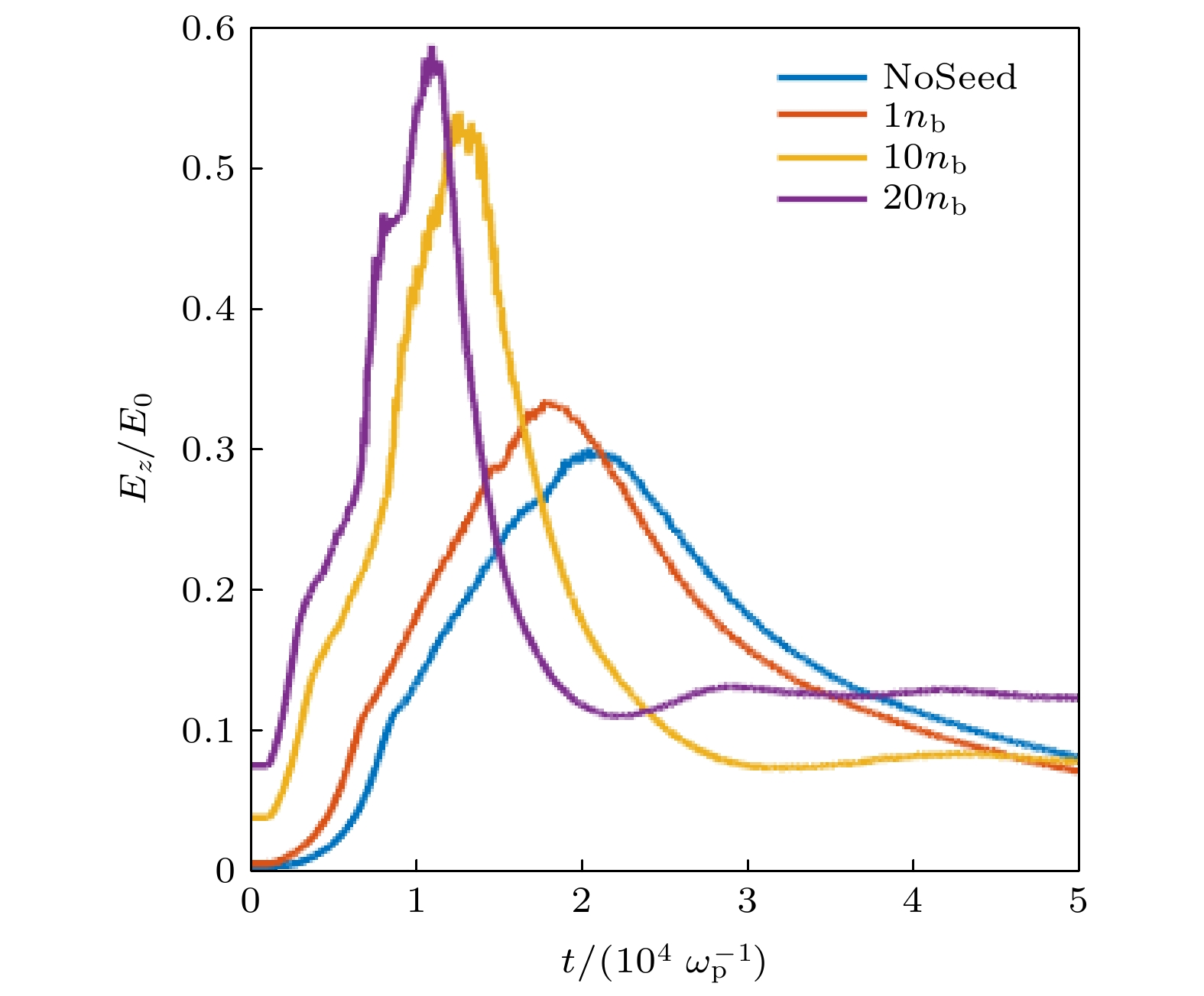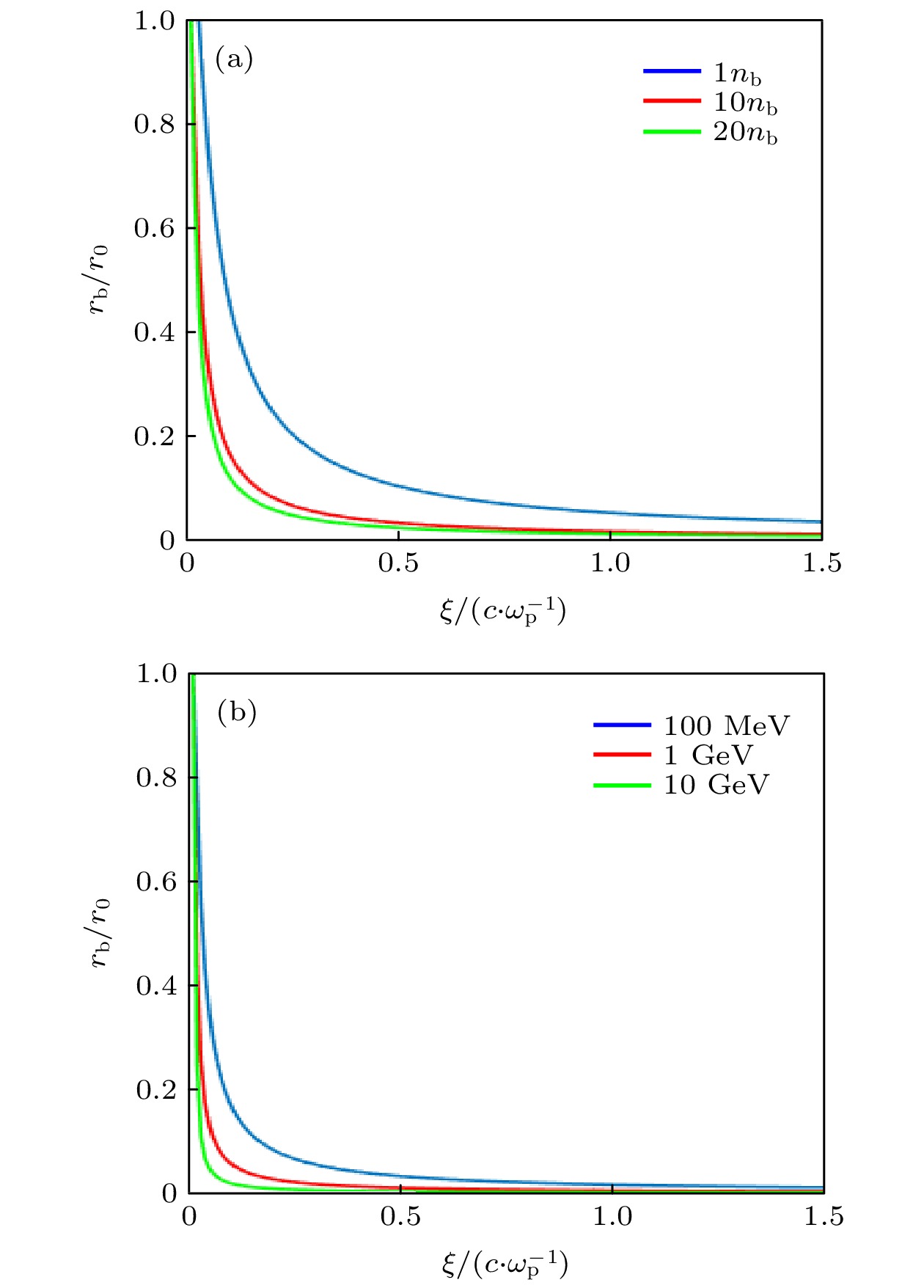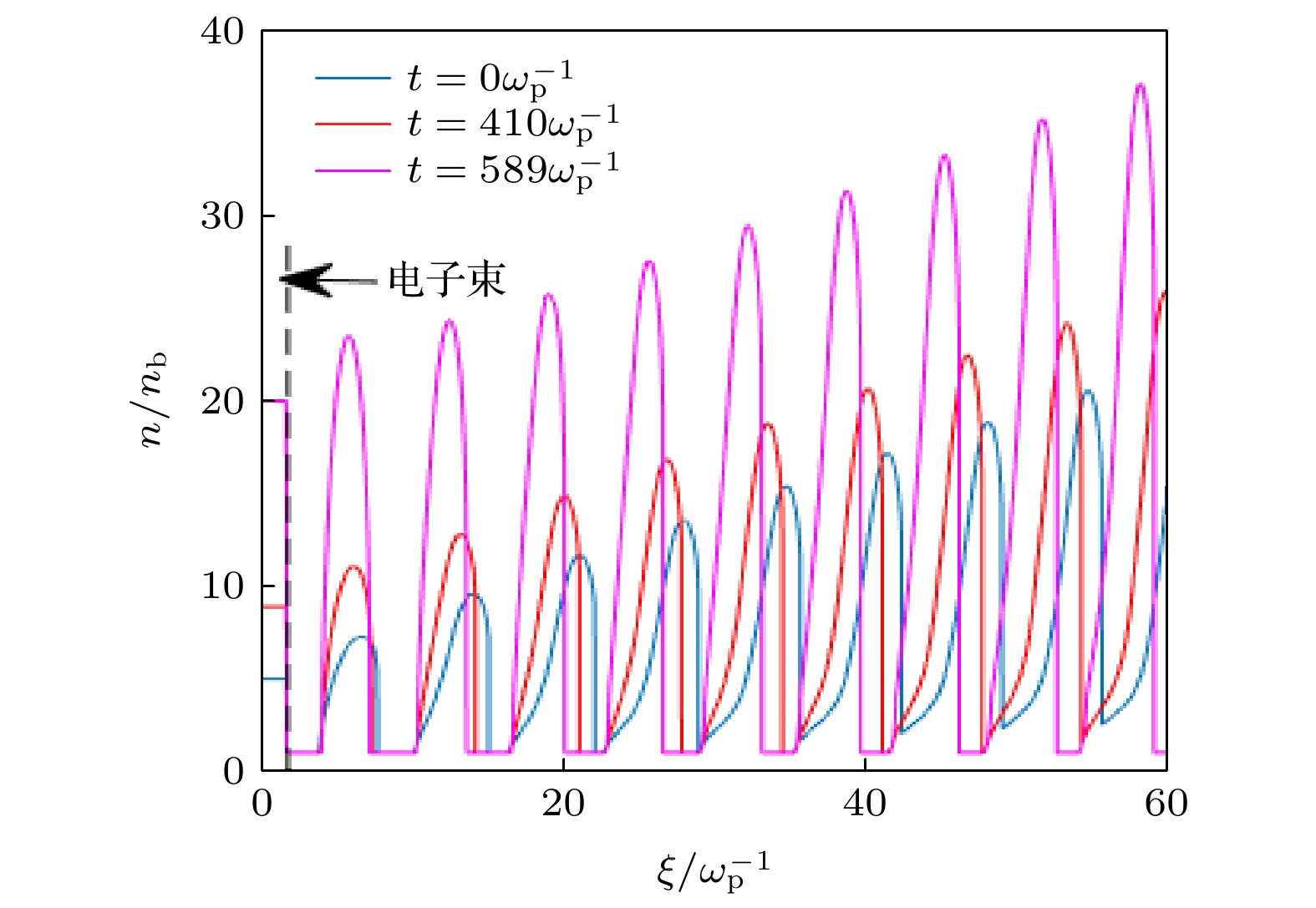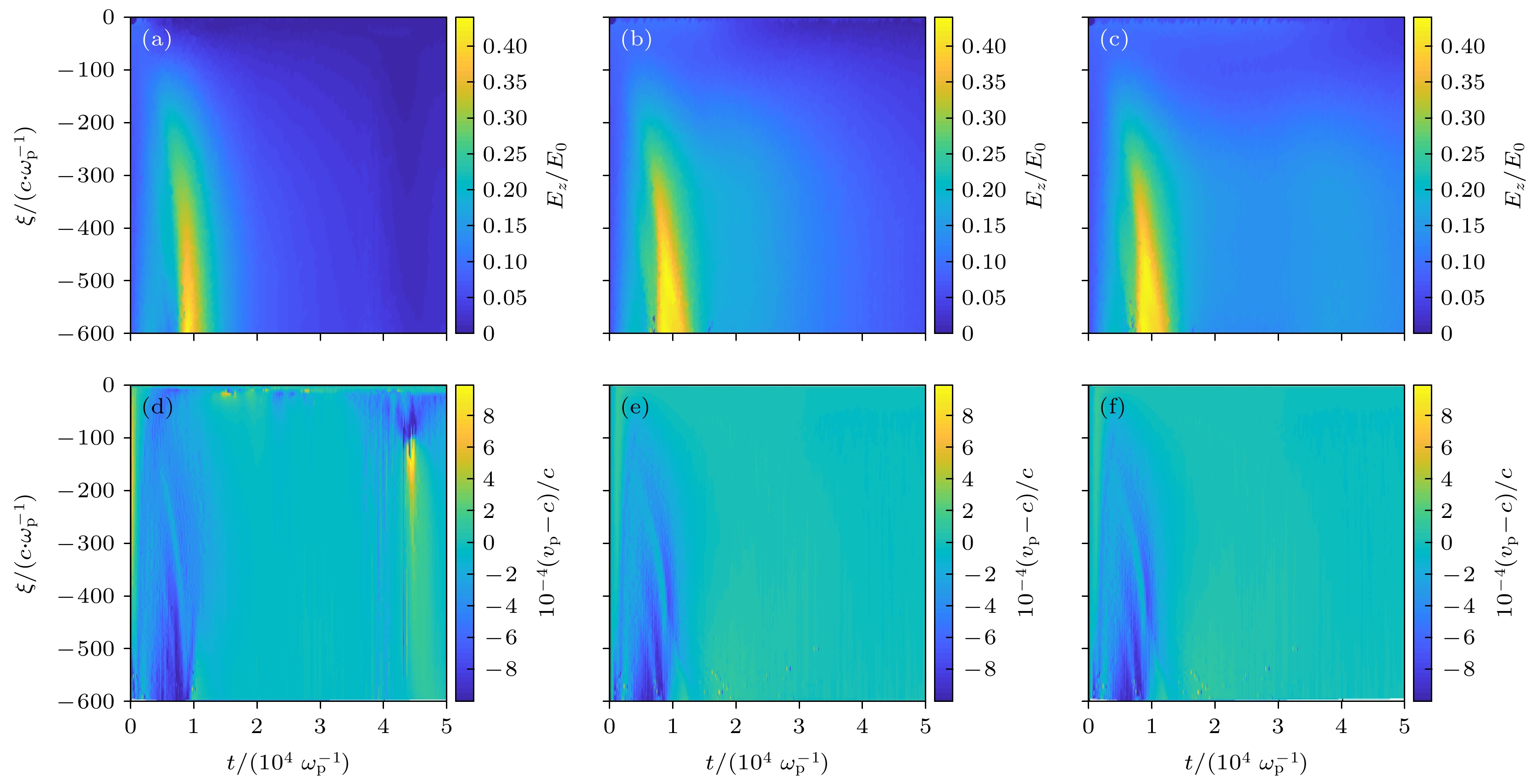-
高能质子束在等离子体中通过自调制不稳定激发尾波的研究在过去的十年里有了长足的发展, 在欧洲核子研究中心(CERN)人们已经在相关AWAKE实验中利用这种尾波加速电子, 并获得了最高能量约2 GeV的电子束. 针对高能粒子加速应用需求, 近几年人们又进一步提出了利用电子束种子尾波控制质子束自调制过程的方案, 用于提升尾波的强度与稳定性. 本文研究了电子束种子尾波对质子束自调制尾波相速度的影响, 着重讨论了导致尾波相速度改变的多种物理机理及电子束所起到的作用. 通过理论分析和二维粒子模拟研究发现, 电子束的引入可以提升质子束自调制尾波的增长率和尾波的相速度, 且电子束的电荷密度越高其效果愈明显. 本文还探讨了电子束能量和质子束的纵向密度分布对相速度变化的影响.Significant progress has been made in the studies of wakefield excitation in plasma by a self-modulated high energy proton beam in the past decade. The electron beams accelerated up to 2 GeV by using such a wakefield were demonstrated in the AWAKE experiment at CERN in 2018. Aiming at the application of high energy particle accelerators, new ideas have been investigated in recent years, such as seeding the proton beam self-modulation with an electron beam in order to enhance the strength and stability of the wakefield or adding a density transition in the plasma distribution to enhance the phase velocity and the strength of the wakefield. Here in this work, we investigate the effects of electron beam seeding on the phase velocity of the wakefield generated by the modulated proton beam in plasma. The physical mechanisms responsible for the phase velocity change and the roles played by the electron beam seeding are discussed. The theoretical analysis and two-dimensional particle-in-cell simulations show that both the growth rate and the phase velocity of the wakefield generated by the modulated proton beam can be enhanced by the electron beam seeding. The higher the charge density of the electron beam, the more significant the enhancement effects. The effects of electron beam energy and proton beam longitudinal profiles on the increase of phase velocity are also studied. It is shown that the evolution of the electron beam distribution has a significant effect on the seeding self-modulation process, and thus affecting the phase velocity. A self-focusing electron seeding beam can increase the phase velocity of the wakefield even to superluminal while an expanding seeding beam can reduce the phase velocity and destroy the stability of the whole process. This work may benefit the proton beam seeding self-modulation acceleration and its applications.
-
Keywords:
- plasma wakefield acceleration /
- self-modulation of proton beams /
- wakefield phase velocity /
- electron beam seeding
[1] Joshi C, Katsouleas T 2003 Phys. Today 56 47
[2] Esarey E, Sprangle P, Krall J, Ting A 1996 IEEE Trans. Plasma Sci. 24 252
 Google Scholar
Google Scholar
[3] Kudryavtsev A M, Lotov K V, Skrinsky A N 1998 Nucl. Instrum Methods A 410 388
 Google Scholar
Google Scholar
[4] Rosenzweig J, Barov N, Murokh A, Colby E, Colestock P 1998 Nucl. Instrum Methods A 410 532
 Google Scholar
Google Scholar
[5] Shiltsev V D 2012 Phys. Usp. 55 965
 Google Scholar
Google Scholar
[6] Pukhov A, Meyer-ter-Vehn J 2002 Appl. Phys. B 74 355
[7] Li W T, Wang W T, Liu J S, Wang C, Zhang Z J, Qi R, Yu C H, Li R X, Xu Z Z 2015 Chin. Phys. B 24 015205
 Google Scholar
Google Scholar
[8] Shen Z C, Min C, Zhang G B, Luo J, Weng S M, Yuan X H, Liu F, Sheng Z M 2017 Chin. Phys. B 26 115204
 Google Scholar
Google Scholar
[9] 祝昕哲, 刘维媛, 陈民 2020 物理学报 69 035201
 Google Scholar
Google Scholar
Zhu X Z, Liu W Y, Chen M 2020 Acta Phys. Sin. 69 035201
 Google Scholar
Google Scholar
[10] Caldwell A, Lotov K, Pukhov A, Simon F 2009 Nat. Phys. 5 363
 Google Scholar
Google Scholar
[11] Xia G, Caldwell A, Lotov K, Pukhov A, Kumar N, An W, Lu W, Mori B, Joshi C, Huang C, Muggli P, Assmann R 2010 AIP Conf. Proc. 1299 510
[12] Kumar N, Pukhov A, Lotov K 2010 Phys. Rev. Lett. 104 255003
 Google Scholar
Google Scholar
[13] Batsch F 2020 J. Phys. Conf. Ser. 1596 012006
 Google Scholar
Google Scholar
[14] Caldwell A, Adli E, Amorim L, et al. 2016 Nucl. Instrum Methods A 829 3
 Google Scholar
Google Scholar
[15] Adli E, Ahuja A, Apsimon O, et al. 2018 Nature 561 363
 Google Scholar
Google Scholar
[16] Turner M, Adli E, Ahuja A, et al. 2019 Phys. Rev. Lett. 122 054801
 Google Scholar
Google Scholar
[17] Martorelli R, Pukhov A 2016 Phys. Plasmas 23 053109
 Google Scholar
Google Scholar
[18] Siemon C, Khudik V, Austin Yi S, et al. 2013 Phys. Plasmas 20 103111
 Google Scholar
Google Scholar
[19] Schroeder C B, Benedetti C, Esarey E, et al. 2011 Phys. Rev. Lett. 107 145002
 Google Scholar
Google Scholar
[20] Pukhov A, Kumar N, Tückmantel T, et al. 2011 Phys. Rev. Lett. 107 145003
 Google Scholar
Google Scholar
[21] Schroeder C B, Benedetti C, Esarey E, et al. 2012 Phys. Rev. E 86 026402
 Google Scholar
Google Scholar
[22] Muggli P, Morales Guzman P I, Bachmann A M, Hüther M, Moreira M, Turner M, Vieira J 2020 J. Phys. Conf. Ser. 1596 012066
 Google Scholar
Google Scholar
[23] Lotov K V, Minakov V A 2020 Plasma Phys. Controlled Fusion 62 115025
 Google Scholar
Google Scholar
[24] Lotov K V 2003 Phys. Rev. Spec. Top. Accel. Beams 6 061301
 Google Scholar
Google Scholar
[25] Li Y 2020 Studies of Proton Driven Plasma Wakefield Acceleration (Springer Nature Press) pp43−47.
[26] Lotov K V 2013 Phys. Plasmas 20 083119
 Google Scholar
Google Scholar
-
图 2 电子束种子自调制模拟结果 (a) 无电子束时的最大电场分布; (b) 无电子束时的相速度分布; (c) 电子束中心密度为
$ 1{n}_{\mathrm{b}} $ 时的最大电场分布; (b) 电子束中心密度为$ 1{n}_{\mathrm{b}} $ 时的相速度分布; (e) 电子束中心密度为$ 10{n}_{\mathrm{b}} $ 时的最大电场分布; (f) 电子束中心密度为$ 10{n}_{\mathrm{b}} $ 时的相速度分布Fig. 2. Results of the simulation: (a) Distribution of Emax when no seeding; (b) distribution of phase velocity when no seeding; (c) distribution of Emax when
$ {n}_{\mathrm{b}\mathrm{e}}=1{n}_{\mathrm{b}} $ ; (d) distribution of phase velocity when$ {n}_{\mathrm{b}\mathrm{e}}=1{n}_{\mathrm{b}} $ ; (e) distribution of Emax when$ {n}_{\mathrm{b}\mathrm{e}}=10{n}_{\mathrm{b}} $ ; (f) distribution of phase velocity when$ {n}_{\mathrm{b}\mathrm{e}}=10{n}_{\mathrm{b}} $ .图 3 (a) 不同电子束密度
$ {n}_{\mathrm{b}\mathrm{e}} $ 情况下尾波峰值相位的变化; (b)$ \xi =100\; c/{\omega }_{\mathrm{p}} $ 处不同$ {n}_{\mathrm{b}\mathrm{e}} $ 条件下模拟得到的尾波相速度随时间变化; (c)$ \xi =300\; c/{\omega }_{\mathrm{p}} $ 处不同$ {n}_{\mathrm{b}\mathrm{e}} $ 条件下模拟得到的尾波相速度随时间变化Fig. 3. (a) Phase change of the wakefield peak with different electron beam density
$ {n}_{\mathrm{b}\mathrm{e}} $ ; (b) evolution of the phase velocity at$ \xi =100 c/{\omega }_{\mathrm{p}} $ with different$ {n}_{\mathrm{b}\mathrm{e}} $ ; (c) evolution of the phase velocity at$ \xi =300 c/{\omega }_{\mathrm{p}} $ with different$ {n}_{\mathrm{b}\mathrm{e}} $ .图 5 (a) 电子束能量
$ {E}_{\mathrm{b}\mathrm{e}}=100\mathrm{M}\mathrm{e}\mathrm{V} $ 时不同电子束密度$ {n}_{\mathrm{b}\mathrm{e}} $ 的平衡态分布; (b)$ {n}_{\mathrm{b}\mathrm{e}}=10{n}_{\mathrm{b}} $ 时不同电子束能量$ {E}_{\mathrm{b}\mathrm{e}} $ 的平衡态分布Fig. 5. (a) Equilibrium configuration with different electron beam density
$ {n}_{\mathrm{b}\mathrm{e}} $ when Ebe =100 MeV; (b) equilibrium configuration with different E when$ {n}_{\mathrm{b}\mathrm{e}}=10{n}_{\mathrm{b}} $ .图 7 利用电子束种子尾波调制质子束的模拟结果 (a), (b), (c)分别对应电子束能量
$ {E}_{\mathrm{b}\mathrm{e}} $ = 100 MeV, 500 MeV, 1 GeV时的最大电场随时间变化; (d), (e), (f) 分别对应电子束能量$ {E}_{\mathrm{b}\mathrm{e}} $ = 100 MeV, 500 MeV, 1 GeV时的相速度随时间变化Fig. 7. Simulation of proton beam modulation with electron beam seeding:(a), (b), (c) The maximum electric fields as a function of time for the electron beam energy at
${E}_{\mathrm{b}\mathrm{e}}=100~\mathrm{M}\mathrm{e}\mathrm{V}$ , 500 MeV, and 1 GeV, respectively; (d), (e), (f) the phase velocity as a function of time for the electron beam energy at${E}_{\mathrm{b}\mathrm{e}}=100~\mathrm{M}\mathrm{e}\mathrm{V}$ , 500 MeV, and 1 GeV, respectively.图 8 (a) 在
$ \xi =100 c/{\omega }_{\mathrm{p}} $ 处不同电子束能量模拟得到的尾波相速度随时间变化; (b) 在$ \xi =300 c/{\omega }_{\mathrm{p}} $ 处不同电子束能量模拟得到的尾波相速度随时间变化Fig. 8. (a) Phase velocity as a function of time at
$ \xi =100 c/{\omega }_{\mathrm{p}} $ for different electron energy; (b) phase velocity as a function of time at$ \xi =300 c/{\omega }_{\mathrm{p}} $ for different electron energy. -
[1] Joshi C, Katsouleas T 2003 Phys. Today 56 47
[2] Esarey E, Sprangle P, Krall J, Ting A 1996 IEEE Trans. Plasma Sci. 24 252
 Google Scholar
Google Scholar
[3] Kudryavtsev A M, Lotov K V, Skrinsky A N 1998 Nucl. Instrum Methods A 410 388
 Google Scholar
Google Scholar
[4] Rosenzweig J, Barov N, Murokh A, Colby E, Colestock P 1998 Nucl. Instrum Methods A 410 532
 Google Scholar
Google Scholar
[5] Shiltsev V D 2012 Phys. Usp. 55 965
 Google Scholar
Google Scholar
[6] Pukhov A, Meyer-ter-Vehn J 2002 Appl. Phys. B 74 355
[7] Li W T, Wang W T, Liu J S, Wang C, Zhang Z J, Qi R, Yu C H, Li R X, Xu Z Z 2015 Chin. Phys. B 24 015205
 Google Scholar
Google Scholar
[8] Shen Z C, Min C, Zhang G B, Luo J, Weng S M, Yuan X H, Liu F, Sheng Z M 2017 Chin. Phys. B 26 115204
 Google Scholar
Google Scholar
[9] 祝昕哲, 刘维媛, 陈民 2020 物理学报 69 035201
 Google Scholar
Google Scholar
Zhu X Z, Liu W Y, Chen M 2020 Acta Phys. Sin. 69 035201
 Google Scholar
Google Scholar
[10] Caldwell A, Lotov K, Pukhov A, Simon F 2009 Nat. Phys. 5 363
 Google Scholar
Google Scholar
[11] Xia G, Caldwell A, Lotov K, Pukhov A, Kumar N, An W, Lu W, Mori B, Joshi C, Huang C, Muggli P, Assmann R 2010 AIP Conf. Proc. 1299 510
[12] Kumar N, Pukhov A, Lotov K 2010 Phys. Rev. Lett. 104 255003
 Google Scholar
Google Scholar
[13] Batsch F 2020 J. Phys. Conf. Ser. 1596 012006
 Google Scholar
Google Scholar
[14] Caldwell A, Adli E, Amorim L, et al. 2016 Nucl. Instrum Methods A 829 3
 Google Scholar
Google Scholar
[15] Adli E, Ahuja A, Apsimon O, et al. 2018 Nature 561 363
 Google Scholar
Google Scholar
[16] Turner M, Adli E, Ahuja A, et al. 2019 Phys. Rev. Lett. 122 054801
 Google Scholar
Google Scholar
[17] Martorelli R, Pukhov A 2016 Phys. Plasmas 23 053109
 Google Scholar
Google Scholar
[18] Siemon C, Khudik V, Austin Yi S, et al. 2013 Phys. Plasmas 20 103111
 Google Scholar
Google Scholar
[19] Schroeder C B, Benedetti C, Esarey E, et al. 2011 Phys. Rev. Lett. 107 145002
 Google Scholar
Google Scholar
[20] Pukhov A, Kumar N, Tückmantel T, et al. 2011 Phys. Rev. Lett. 107 145003
 Google Scholar
Google Scholar
[21] Schroeder C B, Benedetti C, Esarey E, et al. 2012 Phys. Rev. E 86 026402
 Google Scholar
Google Scholar
[22] Muggli P, Morales Guzman P I, Bachmann A M, Hüther M, Moreira M, Turner M, Vieira J 2020 J. Phys. Conf. Ser. 1596 012066
 Google Scholar
Google Scholar
[23] Lotov K V, Minakov V A 2020 Plasma Phys. Controlled Fusion 62 115025
 Google Scholar
Google Scholar
[24] Lotov K V 2003 Phys. Rev. Spec. Top. Accel. Beams 6 061301
 Google Scholar
Google Scholar
[25] Li Y 2020 Studies of Proton Driven Plasma Wakefield Acceleration (Springer Nature Press) pp43−47.
[26] Lotov K V 2013 Phys. Plasmas 20 083119
 Google Scholar
Google Scholar
计量
- 文章访问数: 6203
- PDF下载量: 79
- 被引次数: 0













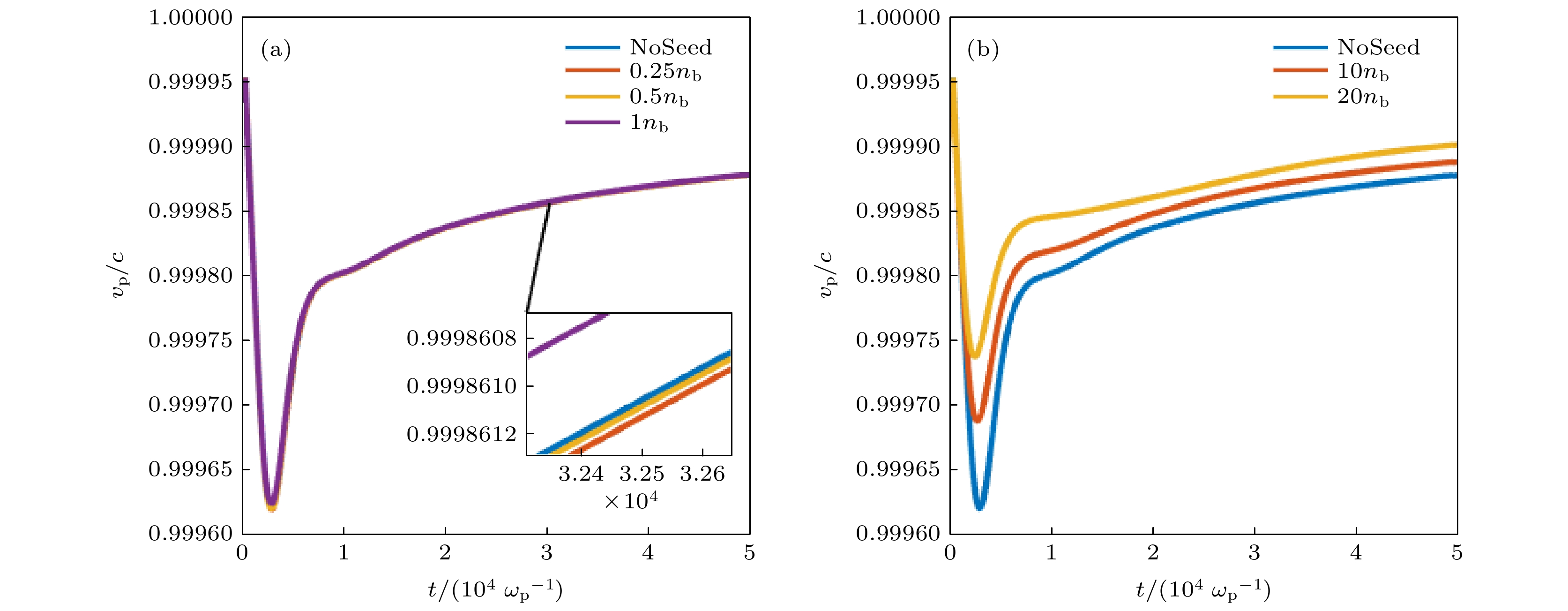


 下载:
下载:
